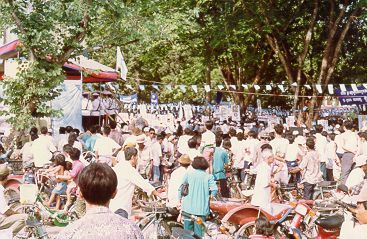Readings: Doyle, Michael W.
Heder, Steve and Judy Ledgerwood
Ledgerwood, Judy
On May 23-28, 1993 Cambodians went to the polls to vote in an election organized by the United Nations. The first day was a frightening and very moving day. The Party of Democratic Kampuchea (PDK), otherwise known as the Khmer Rouge, waged a propaganda campaign telling citizens to oppose the elections. They proclaimed that anyone who voted in the election organized by the "UNTACists" and the "Vietnamese puppets," as the Khmer Rouge referred to the State of Cambodia (SOC), would be considered "traitors to the nation." This propaganda line played daily on the Voice of the Great National Union Front, Khmer Rouge radio. It was also the message of armed propaganda teams who infiltrated into villages at night in some parts of the country and threatened people with death if they voted. The UNTAC electoral and military components were faced with agonizing decisions about whether or not to open polling sites in specific villages. The electoral staff, most of whom had been living on the ground in the district towns for months, and who worked entirely with local staff, pushed for higher numbers of polling stations to ensure the highest possible turnout. The military, responsible for security for the sites, argued for limiting the number so that their forces would not be stretched too thin. In Kompong Cham province, where I spent the month before and during the election and which is the most densely populated province in the country, the decision was made to extend the polling period so that troops could be deployed at every site. By doing so, electoral workers could open polling sites in every district in the province. Military intelligence sources reported Khmer Rouge resupply into the area, including B-40 shoulder mount grenade launchers and 107 mm. rockets. The best guesses were that Khmer Rouge soldiers had been ordered to attack polling sites. Everyone held his or her breath. The question was, would Cambodians risk going to the polls?
Before I can begin my discussion of whether or not the UNTAC organized elections in Cambodia were "free and fair," I should provide some historical and political context for this discussion. In the spring of 1989, the Peoples’ Republic of Kampuchea (PRK) changed its name to the State of Cambodia, and announced sweeping reforms. These included reinstating Buddhism as the state religion and allowing for a free market economy. The most important of these reforms allowed for the private ownership of land, and the government began issuing deeds to some farmers. In September of 1989, the Vietnamese withdrew their military forces from Cambodia. Although there were clearly some Vietnamese soldiers in the country, in advisory capacities and as technical trainers, the consensus was that Vietnam had withdrawn. The developments in Cambodia paved the way for a series of negotiations that eventually resulted in the signing of the Paris Peace Agreement on Cambodia in 1991. This in turn led to what was at the time the largest UN Peacekeeping mission in history. The total cost was estimated at two billion dollars. The mission deployed more than 22,000 personnel, including 15,000 soldiers. UNTAC, or the United Nations Transitional Authority in Cambodia, was divided into eight major components: the military, civilian police, electoral, human rights, rehabilitation, repatriation, civil administration and information/education. Military battalions were deployed throughout the country to provide security; engineering battalions worked to repair the country’s roads and bridges, and United Nations Military Observers or UNMOs were responsible for monitoring cease-fire violations (see Ledgerwood 1994). I worked for the Information/Education Division of UNTAC. This division produced propaganda for the UN designed to inform the population about the goals of the mission and most importantly about the upcoming election. The Information/Education Division was in theory also supposed to "control" the local Khmer media. What we in fact ended up doing was monitoring the Khmer media and calling attention to the most egregious violations of the Paris Agreements. I read newspapers, monitored radio and television broadcasts and wrote reports for UNTAC on their contents. I also traveled throughout the country to gauge the extent to which information from various sources was being received in the countryside. This was then fed back into UNTAC production -- i.e. people need more programming on X or Y. What the vast majority of rural Cambodians saw of UNTAC, besides their ubiquitous white Land Cruisers and Nissan pickups flying down the country roads, were the electoral staff and civilian policemen who were posted throughout the countryside in district towns and who traveled to villages during voter registration and polling. They were also likely to have seen UNTAC military patrolling -- Uruguayans, Pakistanis, Indians, Poles, French, and so on. To return to the central question of this lesson, were the elections that were organized by the UN "free and fair"? There are two ways to frame an answer to this question. The first is in a narrow and literal sense. Was there, as the SOC asserted, "conclusive evidence" of "massive irregularities" and "voter fraud" perpetrated by UNTAC? The second, more encompassing, and far more interesting question is was there a "neutral political environment" in the period leading up to and during the election as stipulated in the Paris Agreement? Did the atmosphere of political violence and intimidation unduly influence the outcome of the election? Given the pre-election violence, did the voting generally reflect the will of the electorate? What follows is a brief discussion of each of these two ways of viewing the problem, which concludes that the election was relatively fair. "Massive irregularities": SOC charges of Voting Fraud On May 30th, 866,498 ballots had been counted nationwide. The Cambodian People's Party, the political party of the SOC was winning 44 percent to FUNCINPEC's 37.8 percent. On May 31 as the counting passed 1,800,000 ballots, or 43 percent of the total vote, FUNCINPEC was in the lead with 36.7 percent of the vote to CPP's 35.3 percent. Everyone -- including SOC, including most "experts" inside UNTAC, including the Khmer Rouge -- had thought that SOC/CPP would win the election. Suddenly SOC officials had to face the possibility that they might lose. On the evening of May 31, Chea Sim and Sar Kheng, the head of the party and the head of the Ministry of Interior of SOC respectively, and Hor Nam Hong, the foreign minister, met with Mr. Akashi, the Special Representative of the Secretary General, his deputy, Mr. Sadry, and Professor Austin, the head of the UNTAC Electoral Component. The SOC officials charged that there had been irregularities in balloting and voting in four areas of the country and asked that a new vote be held in these areas. They were assured that all complaints would be investigated, but were told that there were no plans for new elections. On June 2, the SOC/CPP withdrew its party agents from the counting centers, saying that the irregularities amounted to fraud and that the polling was therefore unjust. The SOC officials demanded that UNTAC stop broadcasting the results of the count as the numbers came in. On June 10th the counting was completed and FUNCINPEC was declared the winner of the election with 45.47 per cent of the votes, CPP had 38.22 per cent, and the Buddhist Liberal Democratic Party (BLDP) 3.81 percent. Since no party had a two-thirds majority as required by the agreement, nor could they get such a majority through an alliance with the smaller third party, the two top vote getters would be forced to form a coalition government. In a daring lunge to retain power by force, or at least bluff their way to a larger portion of the spoils in the new coalition, "renegade" members of the SOC leadership declared the provinces east of the Mekong to be an "autonomous zone." UNTAC personnel were threatened and UNTAC offices attacked and ransacked in an attempt to force them from these eastern areas. Members of opposition parties were driven from these provinces. Some disappeared. After only a few days the "renegades" relented and dropped the secessionist movement, but the media campaign that questioned the results of the elections continued. The charges focused on three main issues. One was the issue of broken seals on the ballot boxes. The second was whether or not party observers had been allowed into the areas where the ballot boxes were stored at night. The third focused on whether or not people could have possibly voted multiple times. Without going into details of each of these and other, more minor issues, let me just highlight some sample stories of this genre of complaints.
The numbers of boxes that allegedly had problems and the circumstances surrounding these stories of bursting boxes grew increasingly bizarre as the stories were told and retold. For example, in Chea Sim's June 9 letter to Yasushi Akashi, he writes "a[s] to information recorded at UNTAC's tendered ballot counting center [in Phnom Penh], 96 boxes arrived with broken locks or seals, 211 boxes arrived without locks or seals, and 39 arrived with new seals. There were even four ballot boxes that arrived at the counting center without both lock and seal! In all, there were 350 tendered ballot boxes with problems..." Two points should be made. First, both the lock and the seal prevented the lid of the box from being slid open. So rather than adding the numbers together, in fact the only boxes from this counting station that might have been opened would have been the four boxes with broken seals and locks -- not 350 boxes. The total number of votes that might have been tampered with was not large enough to affect the outcome of a single seat in the election, let alone the entire election. In cases where seals or locks were broken the boxes were isolated and counted separately. In no case did these results vary significantly from the patterns of the overall count. In the case of the two sets of boxes with broken seals in the city of Phnom Penh, the percentage of CPP votes was 33.1 per cent and 31.4 percent to FUNCINPEC's 52.7 percent and 54.5 percent. This was against a backdrop of a total outcome for the city of 39 per cent CPP and 55.3 per cent FUNCINPEC. There was no evidence that the boxes with broken seals were tampered with. Some boxes with broken seals were mixed with other boxes before counting, because not to do so would have violated the secrecy of the ballot -- all district boxes were mixed, so that no one could know how a single voting site had voted. UNTAC was then accused of not following its word to isolate these boxes. The story that became the centerpiece of the SOC campaign to brand the elections unfair, was the story of a truck in Prey Veng. According to the CPP/SOC version, ballots came flying out of an UNTAC truck. When the ballots were picked up, it was found that they were all marked for the CPP. The truck multiplied in the telling and soon there were ballots flying out of trucks all over the country. The initial story was true, but the media reports did not provide the entire picture. A ballot box had fallen in a truck, the seals broke and the lid slid open. Some ballots flew out of the back of the truck. Immediately behind the truck was a vehicle full of IPSOs (International Polling Station Observers), people who had come from abroad specifically to watch for such problems in the election. In a car behind them were party agents, also watching the boxes being moved to the safe havens. The IPSOs gathered up the scattered ballots and put them back in the box. They resealed the box in the presence of the party agents and the party agents signed a paper that stated that they had witnessed the ballots being returned and the box resealed. In other words, the backup system designed to monitor just such problems had worked. To the stories of broken seals and flying ballots were added the tales of multiple voters. People were interviewed on the radio saying that they had successfully voted two, three, five or more times. Hun Sen, the SOC Prime minister gave an impassioned speech wherein he charged that people had voted up to twenty-five times. Perhaps the most successful target of these claims was the Cambodian polling station officials who had worked for UNTAC. SOC claimed that they had allowed people to vote multiple times, had coached people to vote for FUNCINPEC and had destroyed ballots. CPP party agents went on SOC radio to say that they had been kept out of polling sites illegally. In one typical spot a young man charged that he had been kept out of the polling site for more than two hours. He said, "I don't know what they were doing in there all that time, but I suppose that they were letting people vote twice." While there were definitely problems with the mechanics of voting -- broken seals, the famous flying ballots, officials who were not let into sites promptly and so on -- there is a larger issue. A careful reading of the thick stack of complaints from SOC/CPP makes it clear that what they are really charging is that these mistakes were part of an elaborate plot to remove SOC from power. In this scenario the seals had not broken by chance but were systematically removed so ballots could be added and removed. This activity would have taken place at night in the safe havens throughout the country, which were guarded by soldiers from as many as a dozen different countries. Anyone who knows about the internal workings of UNTAC as a bureaucratic institution found such accusations absurd -- not only because it was an insult to the electoral workers who had worked so hard to manage the polling sites, and the IPSOs who had traveled from all over the world to watch – but also because UNTAC could never have successfully coordinated such massive fraud and kept it secret. This would have involved Indian soldiers and Chilean marines, Pakistanis and Bulgarians sneaking into the safe havens, having the rigged ballots ready, making the switches -- and then not re-sealing the boxes. The humorous part is that the UNTAC military, as indeed all components of UNTAC, could not keep anything secret. UNTAC was not a monolithic entity, but was composed of forces from many different nations with varying views on Cambodia's political situation. Different countries had their own agendas; Japan to try a new role by having soldiers again serve beyond their borders while in relative safety, India to flex some military muscle, Poles and Bulgarians to play a new role in a post -cold war era. While it can certainly be argued that these various goals had good or bad consequences, or perhaps little effect upon Cambodia itself, it is foolish to think that "UNTAC" wanted any specific outcome. The single plot fraud theory is untenable. So in this narrower sense of was the voting rigged, the answer is a no. But the media campaign on this point was a relatively effective one. Many Cambodians were left with some doubts in their mind as to whether or not the voting had been entirely fair. Interestingly however, Khmer seemed most willing to believe that their fellow countrymen, the Khmer workers for UNTAC had somehow been responsible, and not the UNTAC overseas contingents.
The search for a "Neutral Political Environment" According to the Paris Peace Accords, the elections in Cambodia could only take place if a "neutral political environment" had been established. To secure a "neutral political environment," or "pareakas neobay appeacret" in Khmer was one of the main goals of UNTAC.
In the months before the election, Cambodia was a violent place. Although UNTAC's presence had improved security; for example, it was then possible to drive the main highways of the country; the tension of the upcoming election resulted in political violence and repression. The State of Cambodia engaged in systematic political repression against opposition political parties. The intimidation including following people, verbal threats, firing weapons near party offices, arresting or otherwise harassing friends or relatives of party activists and in some cases, in murder (see Ledgerwood 1996). The State of Cambodia was certainly not alone in this propensity to violence. The Khmer Rouge guerrillas continued their strikes against military and civilian targets throughout the UNTAC period. The general pattern of attack was to enter a village at night and target SOC officials and their families. Sometimes the targets were killed. In other cases they were kidnapped and taken away to serve as porters for the guerrillas. The Khmer Rouge also staged attacks on trains, murdering passengers who looked like they might be in the service of the "Vietnamese puppets." The Khmer Rouge specifically targeted ethnic Vietnamese residents of Cambodia (see Jordens 1996). Between early 1992 when UNTAC arrived and September of 1993, the Khmer Rouge were blamed in the deaths of 130 Vietnamese. At least 75 others were injured in these politically motivated attacks. The worst attack came 10 March 1993 at the village of Chong Khneas on the Tonle Sap in Siem Riep province. The Khmer Rouge came to the floating village by boat and opened fire into a crowded floating video parlor and the surrounding homes. The shooting lasted for 15 to 30 minutes. Thirty-three people were killed and at least 24 wounded. Most of these were women and children who were watching the video. Nor were the FUNCINPEC and KPNLF zones areas of peace and neutrality. No formal legal systems existed in these areas and violent solutions to problems, whether economic or political, were common. Extrajudicial executions occurred. To SOC's credit, it allowed party agents from FUNCINPEC, the BLDP and other parties to open offices throughout the areas that it controlled – which was most of the country -- even if they were subsequently harassed and attacked. No such access was even considered in the guerrilla zones. In addition to the problems of politically ordered violence, there was the larger context of a well-armed population in a time of great upheaval. Soldiers of all of these four armies, or from no particular army, would change into the clothing of their enemy or into civilian clothing to steal from the population. After 20 years of warfare, many men had served in more than one army. Traffic on the major highways and on the rivers was subject to extortion at shockingly regular intervals. In most of the country SOC soldiers or police manned these extortion points, but each of the factions had such "checkpoints." On the Mekong River these checkpoints were deadly serious. SOC soldiers were known to open fire into crowded boats if the craft tried to pass without paying. The point is that Cambodians were afraid. It was in this context that I was one of the UNTAC "experts" who predicted a SOC victory in the elections. I thought that Cambodians in many areas would be too terrified of the Khmer Rouge to go to the polls, and that in the more secure (from the Khmer Rouge) areas of the country, the political pressure would be so overwhelming that people would feel that they had to vote for the CPP/SOC.
What is Neutrality? So given this political and social context, how can I make the argument that the election was relatively "free and fair"? I want to return for a moment to the phrase "neutral political environment." While a calm atmosphere and level playing field implied by the term did not exist in the run up to the election, UNTAC did provide the security and means for political parties to campaign, and the technical knowledge and materials for the election mechanics to work properly. Each side had claimed throughout the mission that UNTAC was siding with their enemies. UNTAC cooperated very closely with SOC civil and military authorities; so such so that many people thought that they were one and the same. The SOC media encouraged these perceptions. The Khmer Rouge and the former resistance groups referred to UNTAC in their media as "Yuentac," using the pejorative term for Vietnamese – since they alleged a Vietnamese, SOC-CPP, UNTAC conspiracy. At the same time the SOC claimed that UNTAC was engaged in a plot with the resistance factions and the Khmer Rouge to return the latter to power. UNTAC attempts at "control" of the civil administration could only really be applied to SOC government institutions. When they tried to do so, SOC saw this as unfair, while the other parties to the agreement saw the failure of the agreement in UNTAC’s lack of success in this area. SOC essentially retained control of the country throughout the mission. Yet I would still maintain that the elections were relatively free and fair. First, the parties were able to campaign. The various political parties were able to open offices in Phnom Penh and in the provinces. They were able to conduct campaign rallies and they had access to media, particularly in the form of radio UNTAC. In my travels throughout the country prior to the election, I found that contrary to many Western, and even urban Khmer, attitudes about the sophistication of rural Khmer, rural voters I interviewed generally knew the different political parties, their leaders and their ideas on a range of issues. Second, people obviously decided that it would be safe to vote. To the extent that they assessed that there was some danger, they decided it was worth the risk. There was a time just before the election, after the death of a Japanese electoral volunteer, when the election was almost canceled. Some UNTAC electoral volunteers resigned and openly asked how many of their numbers would have to die before UNTAC would admit failure and cancel the polling. Other electoral staff, including most Khmer staff, pushed for the elections to be held, even at risk to their personal security. During the voting, it was SOC soldiers, and to a lesser extent UNTAC military that provided security at the polling sites. One polling station in Kompong Cham along the river was attacked by Khmer Rouge with rockets. The rockets landed 100 meters or so off target and when SOC forces went to investigate the attackers fled. The electoral staff closed the polling station and fled. When I arrived on the scene an hour or so later with UNTAC military observers, we found the voters were still cued up waiting to vote. They wanted to know why the UNTAC workers had fled. The military radioed to the electoral staff who returned and reopened the site that afternoon. Third, the mechanics of the election were handled professionally and fairly. Logistical arrangements for the voting were largely the work of the electoral component. They traveled throughout the country, registering voters and conducted educational programs. They set up the infrastructure necessary to open polling sites. Each site really had a generator and the correct number of paper cups for dipping fingers, the lights for checking hands and so on. The importance of these detailed arrangements being maintained in a relatively uniform manner over such a large area with a poor infrastructure should be emphasized. Fourth, and perhaps most importantly, UNTAC convinced the Cambodian populous that the vote was secret. This was despite efforts by all of the factions to allege that they could determine how an individual had voted. Stories circulated of secret spy satellites that could peak into voting booths from above and magic pencils that would record which box they had been used to check. UNTAC media outlets pounded this message home in endless slogans and jingles. The idea was critical. During the days of the election, some villagers walked out of Khmer Rouge zones and voted. Some observers have argued that the Khmer Rouge changed their orders in the final hours of the election and told their people to go to vote, and to vote for FUNCINPEC. There does not seem to be evidence to support this assertion nationwide. Other Khmer Rouge units attacked polling stations during this same period. It is possible that the border areas with better communications received such orders while interior units did not. However, the situation is likely much more complicated than this. Particular units were probably more hard-line than others, some units in areas close to FUNCINPEC or KPNLF zones would have had personal contact across these divisions. Some people clearly risked their lives to vote in the face of Khmer Rouge threats. People in SOC controlled zones also voted for other party candidates in the face of intimidation to toe the CPP party line. It is clear given the SOC outpouring of resources to turn out the vote that they expected that the higher the voter turnout was, the better their chances. They believed that people would vote for them. In part this must have been confidence in the people's gratitude for the services that they had provided over the previous twelve years. The PRK and SOC had rebuilt schools and hospitals, had slowly, and with little outside assistance, brought the country back to life after the DK years. Protection lay in the fact that when they stepped behind the cardboard partitions no one could see which box they marked. I suspect that many people waited until this crucial instant to decide whether or not to risk voting for an opposition party. Equally important was the protection provided by the fact that the boxes from individual polling sites and districts were mixed together before they were counted. In this way no one could tell how a single district voted, only entire provinces. Finally, the system of observers, both international observers and local party observers also worked effectively. Party observers watched UNTAC local and international staff run the polling stations, they watched the transportation of the ballot boxes and they looked over the shoulders of UNTAC staff as they counted the ballots. I worked for a time as a counter; representatives of the three main parties checked each ballot I opened. They kept their own running tallies of the ballots that were cross-checked against the UNTAC tabulations. The UN organized elections of 1993 provided Khmer with the opportunity to choose from among a range of political parties they were informed about, in a manner that provided security, secrecy of the ballot, and a fairness in counting the vote. |
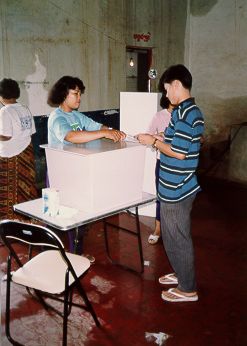 On the morning of May 23rd it was pouring down rain
in Kompong Cham and in many other parts of the country. But from the very first hours that
the polls were open, the question was answered. Not only were they going to come to vote,
they were clamoring to be the first to do so. Long lines formed at polling stations
throughout the country. People stood in the rain for hours. As they came out, they were
beaming. The atmosphere was happy, even jubilant. People had dressed in their best
clothing. UNTAC radio carried live interviews with voters in different parts of the
country. Voters held radios in line and gathered on porches to listen. They knew that this
massive turnout was happening not only in their community, but also throughout the country
and it fed the festive mood.
On the morning of May 23rd it was pouring down rain
in Kompong Cham and in many other parts of the country. But from the very first hours that
the polls were open, the question was answered. Not only were they going to come to vote,
they were clamoring to be the first to do so. Long lines formed at polling stations
throughout the country. People stood in the rain for hours. As they came out, they were
beaming. The atmosphere was happy, even jubilant. People had dressed in their best
clothing. UNTAC radio carried live interviews with voters in different parts of the
country. Voters held radios in line and gathered on porches to listen. They knew that this
massive turnout was happening not only in their community, but also throughout the country
and it fed the festive mood. 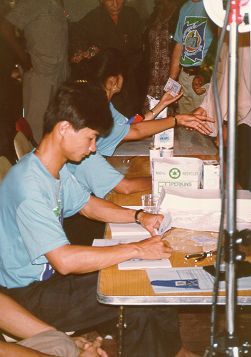 By the end of the day on May 23,
approximately 2.1 million Cambodians had voted -- 42 per cent of the voters had voted on
the first day. There were scattered incidents of violence over the six-day voting period.
Most involved shells landing near polling sites. The polling sites under fire were closed,
but most reopened after SOC soldiers repelled the attackers. By the third day, over 85 per
cent of the registered voters had cast their ballots. During the last three days, small
mobile teams pushed into marginal areas. Turnout was small as most people had already
voted. In the end, more than 90 per cent of the registered population voted in the
election. This is testimony to the bravery of the Cambodian people, and their desire to
see peace in their country.
By the end of the day on May 23,
approximately 2.1 million Cambodians had voted -- 42 per cent of the voters had voted on
the first day. There were scattered incidents of violence over the six-day voting period.
Most involved shells landing near polling sites. The polling sites under fire were closed,
but most reopened after SOC soldiers repelled the attackers. By the third day, over 85 per
cent of the registered voters had cast their ballots. During the last three days, small
mobile teams pushed into marginal areas. Turnout was small as most people had already
voted. In the end, more than 90 per cent of the registered population voted in the
election. This is testimony to the bravery of the Cambodian people, and their desire to
see peace in their country. 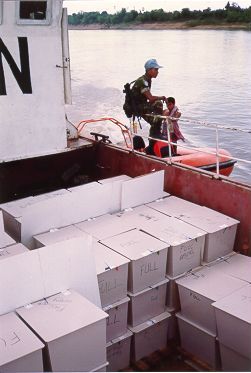 Each ballot box was sealed in two ways. The metal lid
slid into place and it was fixed first with a metal band with a plastic clip on the end
with a number code. Second, there was also a blue plastic seal with another code number
attached. Both seals were applied at the polling site. The boxes were then stacked in
trucks and driven to the district offices where they were stored. Eventually they were
moved by truck, boat or helicopter to the provincial tally sites. Because of the
conditions of Cambodia's roads, these boxes bounced around. In some cases the seals broke.
UNTAC electoral officials realized that they had a problem and on the first day of the
election set up a procedure whereby party agents were on hand when the trucks were
unloaded into the safe havens. If any boxes had broken seals, they were resealed in front
of the party agents. Party agents could witness this unloading into the storage areas, but
they were not allowed to spend the nights in the safe havens with the ballot boxes. No one
was allowed inside the safe havens, which were guarded by UNTAC military.
Each ballot box was sealed in two ways. The metal lid
slid into place and it was fixed first with a metal band with a plastic clip on the end
with a number code. Second, there was also a blue plastic seal with another code number
attached. Both seals were applied at the polling site. The boxes were then stacked in
trucks and driven to the district offices where they were stored. Eventually they were
moved by truck, boat or helicopter to the provincial tally sites. Because of the
conditions of Cambodia's roads, these boxes bounced around. In some cases the seals broke.
UNTAC electoral officials realized that they had a problem and on the first day of the
election set up a procedure whereby party agents were on hand when the trucks were
unloaded into the safe havens. If any boxes had broken seals, they were resealed in front
of the party agents. Party agents could witness this unloading into the storage areas, but
they were not allowed to spend the nights in the safe havens with the ballot boxes. No one
was allowed inside the safe havens, which were guarded by UNTAC military.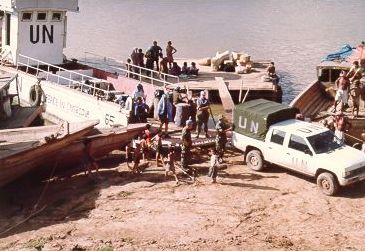
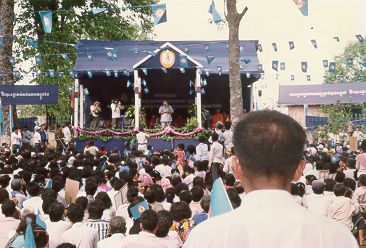 In English, the phrase conjures up images of a calm
and peaceful atmosphere where different political parties have a level playing field in
which to conduct their campaigns. In this ideal world, no "existing administrative
structure" (as the SOC government, the PDK and the non-communist resistance forces
were called in UNTAC-speak), would have the right to unduly influence voters, though they
of course had the right to campaign. In this sense, the assertion that a "neutral
political environment" existed in Cambodia before or during the elections is
obviously unfounded.
In English, the phrase conjures up images of a calm
and peaceful atmosphere where different political parties have a level playing field in
which to conduct their campaigns. In this ideal world, no "existing administrative
structure" (as the SOC government, the PDK and the non-communist resistance forces
were called in UNTAC-speak), would have the right to unduly influence voters, though they
of course had the right to campaign. In this sense, the assertion that a "neutral
political environment" existed in Cambodia before or during the elections is
obviously unfounded.
